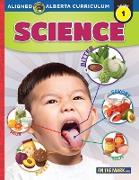- Start
- Alberta Grade 1 Science Curriculum
Alberta Grade 1 Science Curriculum
Angebote / Angebote:
This resource gives students an understanding and appreciation of the five topics from the Alberta Grade 1 Science Curriculum. It's an entire year of Science lessons! In each lesson you will find teacher notes designed to provide you guidance with the learning intentions, the success criteria, materials needed, a lesson outline, as well as providing some insight on what results to expect when the experiments are conducted. The lessons are designed to involve tactile participation and knowledge application while providing opportunities to connect ideas between topics and school subjects. Suggestions for differentiation or accommodation are also included so that all students can be successful in the learning environment.
The Five Topics are:
1. TOPIC A: CREATING COLOURIdentifying Colours
Primary and Secondary Colours
Applying Colours
2. TOPIC B: SEASONAL CHANGESSeasonal Changes
Aboriginal Activities
The Heat of the Sun
Animal Adaptations
Plant Adaptations
3. TOPIC C: BUILDING THINGSConstructing a Birdfeeder
Building a Pop-Up Creature Card and Building a Toy Animal
Building a Water Wheel and a Boat
4. TOPIC D: SENSESExplore Your Senses
Applying Your Senses
Animal Senses
Protecting the Senses
5. TOPIC E: NEEDS OF ANIMALS AND PLANTSThe Animal World
The Plant World
Needs Intertwined
Throughout the experiments, the scientific method is used. The scientific method follows five steps to guide students to discover if evidence supports a hypothesis.
1. Consider a question to investigate. For each experiment, a question is provided for students to consider. For example, "Does direct sunlight
affect water temperature?"
2. Predict what you think will happen. A hypothesis is an educated guess about the answer to the question being investigated. For example, "I believe that direct sunlight warms up the temperature of water." A group discussion is ideal at this point.
3. Create a plan or procedure to investigate the hypothesis. The plan will include a list of materials and a list of steps to follow. It forms the "experiment."
4. Record all the observations of the investigation. Results may be recorded in written, table, or picture form.
5. Draw a conclusion. Do the results support the hypothesis? Encourage students to share their conclusions with their classmates, or in a large
group discussion format.
Assessment & Evaluation: Students can complete the Student Self-Assessment Rubric in order to determine their own strengths and areas for improvement. Assessment can be determined by observation of student participation in the investigation process.
Assessment & Differentiation: The lessons have been designed to work independently or as a unit of study, with high interest and low vocabulary as leading goals. The Glossary of Terms after the Table of Contents can be copied for students and used as a reference, a study game or a "living document" where students add new terms for their own notes.
Meeting Your Students' Needs: The teacher may want to scan any Teacher Notes into a digital format. By doing this, no matter the reading abilities of your students, they will be able to access the information of the text. When appropriate, teachers are also encouraged to allow students to collaborate on as many activities possible. This allows all students to be successful without modifying the text significantly.
Folgt in ca. 10 Arbeitstagen
